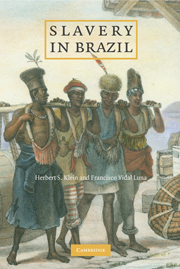6 - Life, Death, and Migration in Afro-Brazilian Slave Society
Published online by Cambridge University Press: 05 June 2012
Summary
The expansion of the export sector in Brazil during four centuries of its evolution was the driving force behind the forced migration of African laborers to the shores of Brazil. Portuguese merchants made this migration possible by opening up the African Atlantic markets and organizing a slave-trading fleet. At the same time, the subsequent growth or decline of these African slaves and their descendants in Brazil was determined by classic demographic factors, such as their birth and death rates, as well as their rates of internal migration and manumission. These are themes that will be explored in this chapter as we summarize the latest studies relating to the population history of these several million forced migrants who arrived in Brazil in the period to 1850.
To transport these estimated 5.5 million workers shipped from Africa across the Atlantic Ocean to Brazil, there emerged a sophisticated and complex system of the purchase of African slaves with goods demanded by the African markets, which in turn linked the economies of Asia, America, and Europe to the evolving market economy in Africa. There is little question that Brazil was the single most important arrival place for African slaves in America. Of the estimated 10.7 million Africans who safely crossed the Atlantic from the late fifteenth century until the late nineteenth century, an estimated 4.8 million survived the crossing and landed in Brazil.
- Type
- Chapter
- Information
- Slavery in Brazil , pp. 151 - 188Publisher: Cambridge University PressPrint publication year: 2009



